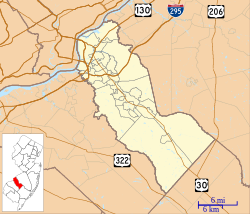Hadrosaurus Foulkii Leidy Site
|
Hadrosaurus Foulkii Leidy Site
|
|

Marl pit at the site, in which the bones were found
|
|
| Location | Haddonfield, New Jersey, USA |
|---|---|
| Coordinates | 39°54′34.1″N 75°1′40.24″W / 39.909472°N 75.0278444°WCoordinates: 39°54′34.1″N 75°1′40.24″W / 39.909472°N 75.0278444°W |
| Built | 1858 |
| NRHP Reference # | 94001648 |
| Significant dates | |
| Added to NRHP | October 12, 1994 |
| Designated NHL | October 12, 1994 |
Hadrosaurus Foulkii Leidy Site in Haddonfield, Camden County, New Jersey, United States, is where the first relatively complete set of dinosaur bones were discovered in 1838, and then fully excavated by William Parker Foulke in 1858. The dinosaur was later named Hadrosaurus foulkii by Joseph Leidy. The site lingered in obscurity until 1984 when a local Boy Scout from Troop 65, Christopher Brees, as part of an Eagle Scout project researched the site and generated publicity, eventually leading to the species being designated the official dinosaur of New Jersey. The site is now a small park known as "Hadrosaurus Park" and is accessed at the end of Maple Avenue.
According to a plaque placed at the site by the Academy of Natural Sciences, the site was part of the John Hopkins farm in 1858. Current information from the Academy states that Foulke unearthed 35 of an estimated 80 bones from the Hadrosaurus, which is believed to have been herbivorous, 7 meters in length, and weigh 2.5 tons. It lived during the Cretaceous Period, 73 million years ago.
Plaques at the site showing National Historic Landmark status (left) and a plaque from Philadelphia's Academy of Natural Sciences. A deep pit or ravine is straight ahead about 10 yards.
A display at the Academy of Natural Sciences of casts of the 35 bones dug up at the site
...
Wikipedia

